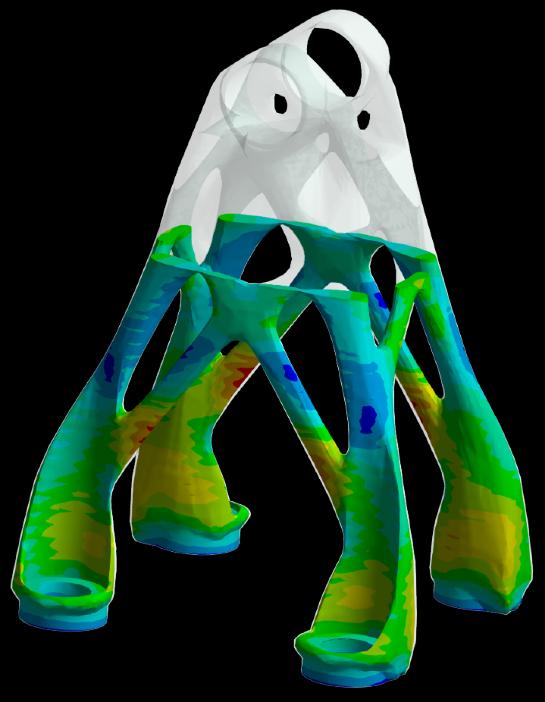Senior Editor
- FMA
- The Fabricator
- FABTECH
- Canadian Metalworking
Our Publications
Categories
- Additive Manufacturing
- Aluminum Welding
- Arc Welding
- Assembly and Joining
- Automation and Robotics
- Bending and Forming
- Consumables
- Cutting and Weld Prep
- Electric Vehicles
- En Español
- Finishing
- Hydroforming
- Laser Cutting
- Laser Welding
- Machining
- Manufacturing Software
- Materials Handling
- Metals/Materials
- Oxyfuel Cutting
- Plasma Cutting
- Power Tools
- Punching and Other Holemaking
- Roll Forming
- Safety
- Sawing
- Shearing
- Shop Management
- Testing and Measuring
- Tube and Pipe Fabrication
- Tube and Pipe Production
- Waterjet Cutting
Industry Directory
Webcasts
Podcasts
FAB 40
Advertise
Subscribe
Account Login
Search
Software will reduce experimentation time when designing 3D-printed parts
ANSYS looks for software solutions that eliminate repeating patterns that slow 3D printing operations
- By Tim Heston
- July 9, 2019
- Article
- Additive Manufacturing
Being in this business for more than 25 years, first in academia and then in the private sector, Brent Stucker has seen his share of additive hype. There’s an ebb and flow to it all. With the hype come the corporate mandates, the chatter from top brass, and investors that push additive manufacturing (AM) no matter how quixotic the effort might be.
“The cycle goes between hype and realism,” Stucker said. “It’s just the way it is. When we’re in a hype cycle, we take a giant leap forward, but then the realities settle in.” Stucker added that the cycle now seems to be ebbing toward realism.
Many manufacturers adopting AM use it mainly for low-volume, noncritical parts; fixtures; and jigs. If they do adopt AM to build critical components, they conduct comprehensive experiments to prove out a concept.
Think of all the investment made in certain medical implants and aerospace fuel nozzles. If a manufacturer can’t afford to conduct such experiments, the part doesn’t make business sense for additive, no matter how elegant the design might be. Even worse, deep-pocketed corporations deem the results of those experiments to be intellectual property and keep them secret. Considering all the money they spent on R&D, who can blame them?
Stucker, the Park City, Utah-based director of additive manufacturing at ANSYS, sees the industry changing course. Driving the change won’t be any one additive technology; it will be software—specifically, design-assist and simulation tools, eventually enhanced by cluster or cloud computing, machine learning, and artificial intelligence. AM simultaneously simplifies and complicates. It simplifies by freeing designers from traditional (e.g., subtractive) manufacturing.
One design, complete with impossible-to-machine features like internal channels, can simplify part design, assembly, and operation. But predicting the behavior of a printing process on a specific part can be incredibly complicated. If you want to predict the way a high-value printed part will behave during printing and in service, a traditional approach to finite element analysis (FEA) just won’t do.
Make a weld with a few passes, and an experienced welder will know how a part will distort (or “shrink”) after welding. But the lasers and other heat sources used in AM make millions of passes. And the cooling happens rapidly, with the cooling cycle of each layer interacting with the next. So how will the part distort after printing, and where will you need to put the supports to account for that distortion? Is heat treating necessary, or can it be eliminated?
These and myriad other questions haven’t been easy to answer, hence the need for experiments.
But software tools, including design-assist and simulation, might change the game. For instance, Stucker’s team has developed software that doesn’t take the traditional approach to FEA, but instead identifies repeating patterns as a system deposits layer after layer. “When we identify the mathematical repetition, we can speed up the whole solution,” he said.
Combine simulation with other tools his team has developed, including design-assist and other software tools that predict effects of heat treatment and even specific microstructures, and the CAD-to-print cycle shortens dramatically. That’s because companies need not run hundreds or thousands of hours of experiments to prove an additive design. Experiments won’t disappear, but they won’t need to be as extensive.
Stucker envisions such software becoming a kind of democratizing backbone of the additive industry. Large companies would have their own cloud and cluster-computing infrastructures to fine-tune their simulations, but smaller companies would still have options. They could use in-house software or, alternatively, upload designs to a software service provider that—with its own cluster computing, machine learning, and artificial-intelligence infrastructure—could run design simulations, charging companies by the minute or hour for the service. Software as a service hasn’t taken off in the design and simulation world yet, “but I’m confident we’ll get there,” Stucker said.
“My dream is that within the next five or 10 years, we’ll have another hockey-stick growth in the additive business,” Stucker continued, “as small and medium-sized enterprises really start to be able to take advantage of the amazing benefits of additive manufacturing.”
About the Author

Tim Heston
2135 Point Blvd
Elgin, IL 60123
815-381-1314
Tim Heston, The Fabricator's senior editor, has covered the metal fabrication industry since 1998, starting his career at the American Welding Society's Welding Journal. Since then he has covered the full range of metal fabrication processes, from stamping, bending, and cutting to grinding and polishing. He joined The Fabricator's staff in October 2007.
About the Publication
- Podcasting
- Podcast:
- The Fabricator Podcast
- Published:
- 04/16/2024
- Running Time:
- 63:29
In this episode of The Fabricator Podcast, Caleb Chamberlain, co-founder and CEO of OSH Cut, discusses his company’s...
- Trending Articles
- Industry Events
16th Annual Safety Conference
- April 30 - May 1, 2024
- Elgin,
Pipe and Tube Conference
- May 21 - 22, 2024
- Omaha, NE
World-Class Roll Forming Workshop
- June 5 - 6, 2024
- Louisville, KY
Advanced Laser Application Workshop
- June 25 - 27, 2024
- Novi, MI



























